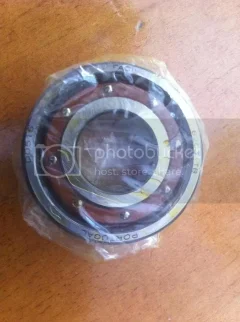to quote pete v
No you can't. And if you had made an effort to make said purchase of a 6203-tb-p6-c3 (aka 6203TB.P63) you would have known for yourself.
But let's give you the benifit of the doubt. There must be dozens global FAG distributors. Please offer up three or four to choose from with pricing and availability.
I will even start it up for you. Notice that the country of orgin is subject to change and the available to order status mean "not in stock". Oh, and don't forget about the price.
http://www.motionindustries.com/motion3 ... q=02297983
Here is another under a different number. Notice the price and availability. I double dog dare you to call this distributer and try to order one. "Non Exsistant" Their FAG rep will tell you what they told me. That FAG has reclassified these bearings and they will be around $300 each and be exclusively made in Germany.
http://www.applied.com/apps/commerce/ca ... 203-TVH-C3
YOU ARE QUICK TO FORGET SIR the good old USA has ( trade restrictions on bearing import ) in the form of a high import duty tariff for foreign made bearings
to protect any USA bearing manufacturing from cheap imports ( in Europe we have a free trade policy ) and our bearing brokers can source without restriction
your FAG / SKF / RHP US distributors may choose not to import due to duty issues and MOQ batch production / sales issues , In Europe we have bearing brokers who actually buy up manufacturers production runs and then supply local distribution companies which all have trade / retail outlets in most sizable towns and city`s
I can assure you we in the UK we can go down to our local distributors and obtain them ( if they are available for sale )
through my work I have regular dealings with one of the UK bearing brokers these guys hold more than 1 million bearings in stock at all times and have access to all global manufacturers stock lists and production dates so they can tell you how much and how long normally within 24 hours and strange as it may seem they also have access to competitors stock lists as they all freely trade stocks
No you can't. And if you had made an effort to make said purchase of a 6203-tb-p6-c3 (aka 6203TB.P63) you would have known for yourself.
But let's give you the benifit of the doubt. There must be dozens global FAG distributors. Please offer up three or four to choose from with pricing and availability.
I will even start it up for you. Notice that the country of orgin is subject to change and the available to order status mean "not in stock". Oh, and don't forget about the price.
http://www.motionindustries.com/motion3 ... q=02297983
Here is another under a different number. Notice the price and availability. I double dog dare you to call this distributer and try to order one. "Non Exsistant" Their FAG rep will tell you what they told me. That FAG has reclassified these bearings and they will be around $300 each and be exclusively made in Germany.
http://www.applied.com/apps/commerce/ca ... 203-TVH-C3
YOU ARE QUICK TO FORGET SIR the good old USA has ( trade restrictions on bearing import ) in the form of a high import duty tariff for foreign made bearings
to protect any USA bearing manufacturing from cheap imports ( in Europe we have a free trade policy ) and our bearing brokers can source without restriction
your FAG / SKF / RHP US distributors may choose not to import due to duty issues and MOQ batch production / sales issues , In Europe we have bearing brokers who actually buy up manufacturers production runs and then supply local distribution companies which all have trade / retail outlets in most sizable towns and city`s
I can assure you we in the UK we can go down to our local distributors and obtain them ( if they are available for sale )
through my work I have regular dealings with one of the UK bearing brokers these guys hold more than 1 million bearings in stock at all times and have access to all global manufacturers stock lists and production dates so they can tell you how much and how long normally within 24 hours and strange as it may seem they also have access to competitors stock lists as they all freely trade stocks

